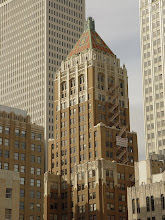Journal Record, The (Oklahoma City), Jun 27, 2008 by Kirby Lee Davis
Richard Winton started renovations on the 80-year-old Philtower last year with every hope of restoring downtown Tulsa's gothic tower to its Class A heritage.
But few things surprised and pleased him more in that effort than the basement discovery of a beaten cardboard box containing not only original construction contracts and blueprints, but family photos, notes and clippings of the building's famed founder, Waite Phillips. The records proved a welcome reminder of the history surrounding him, and the love Tulsa's early philanthropist poured into the 23- floor structure, for a brief time Tulsa's tallest building when it opened in 1928 as the "queen of the skyline."
Phillips started down a construction path after selling his oil company for $25 million in 1925. With wife Genevieve, the entrepreneur started a world tour gathering ideas and furnishings not just for his planned $2.5 million downtown office tower, but his home Villa Philbrook and his New Mexico ranch Villa Philmonte. Ever the maverick, he chose for the Philtower not the art deco styling fast becoming Tulsa's iconic trademark, but an old-world symmetry and style glorified in the new 32-story Southwestern Bell tower in St. Louis, which a Feb. 6, 1927, Tulsa Daily World article said had gained worldwide attention as one of the most beautiful structures in existence.
First conceived as a 21-story building, the Philtower design by honored Kansas City architect Edward Buehler Delk employed late gothic revival styles ranging from entryway gargoyles to an elegant marble lobby with English fan-vaulted ceilings, imported chandeliers and a broad, polished staircase leading to a popular shopping-mall environment on the second and third floors. Capping several floors of offices lined with travertine marble and mahogany, contractor Long Construction Co. of Kansas City finished the 323-foot-tall structure with a pyramid-shaped roof adorned with newfangled neon lights over bright red and green shingles.
Almost everywhere in-between, from the entryway floors to the doorknobs, visitors found Phillips' personal stamp of approval - his initials.
"Phillips spared no expense, although he did try sometimes to cut corners," said Winton, who oversees the building management firm River City Development LLC. "He put oilfield boilers in and it just didn't work out. He had to demolish two levels of floors to get the new boilers in."
For more than a decade Phillips ruled his empire from his top- level penthouse office boasting 20-foot beamed ceilings, richly paneled walls and a huge fireplace. Beneath him a string of notable businesses accumulated in the Philtower as Tulsa's oil capital wealth helped it survive the onset of depression. Phillips himself departed the city at the close of World War II, deeding the Philtower to the Boy Scouts of America four years earlier.
The building remained a center of commerce for decades, claiming such tenants through the years as Miss Jackson's Shop; the KVOO-AM basement studio, where such artists performed as Bob Wills and the Texas Playboys, Fibber McGee and Molly, Bing Crosby, Will Rogers, Paul Harvey and Mae West; the Frates Co. insurance and bond office; the office of Walter H. Helmerich and William T. Payne; Texaco; Reading and Bates, and Halliburton.
A new era was promised when the Tulsa investor group Philtower LLC bought the building in 1977, gaining a National Register of Historic Places listing two years later. Downtown Tulsa seemed on the edge of a renaissance, with the construction of First Place Tower, a new Williams headquarters and entertainment complex, the rise of the new Tulsa Performing Arts Center, and plans for a Reading and Bates skyscraper. But then came the fall of Penn Square Bank and the collapse of oil prices, starting two decades of takeover and relocation among the city's prized oil companies.
With new potential brewing after the 2003 passage of the Vision 2025 tax program, Philtower LLC attempted a gutsy experiment, converting nine upper floors into condominiums. After two years of planning and construction, the owners received vindication by selling all of the available units within a year. River City Development now hopes a general restoration, incorporating environmentally friendly systems wherever possible, will restore the remaining offices and retail space to Class A status.
"The building has always been considered a gem," said former HTB architect Rex Ball. "Always. From the day it was built. There was never a period when it was ever out of style."
Kirby Lee Davis "These Walls: The Philtower in Tulsa". Journal Record, The (Oklahoma City). . FindArticles.com. 18 Sep. 2008. http://findarticles.com/p/articles/mi_qn4182/is_20080627/ai_n27884977
Articles in Jun 27, 2008, issue of Journal Record, The (Oklahoma City)
http://findarticles.com/p/articles/mi_qn4182/is_20080627/ai_n27884977
skip to main |
skip to sidebar



Twitter Updates
Simply Stated By RealSimple.com
Real Simple Blogs: Technology
Boston Building - Chic Downtown Tulsa Office Building
Urban Tulsa Weekly | News : City, State, County, Education
Followers
Subscribe Now: Feed Icon
Philtower on YouTube
HGTV's "Design Happens"
Yahoo Buzz
eTips
Decidio.com
| FEATURED VENDOR Tulsa, Oklahoma Banquet Facilities Directory at Decidio.com |
Philtower LoopNet Listing
Loft Bedroom

Loft Dining Room

TulsaWorld.com - News
Blog Archive
-
▼
2008
(33)
-
▼
September
(7)
- Tulsa Wedding Venues
- Philtower Office Building on MySpace
- Philtower Commercial Property for Lease Close to D...
- Submitexpress.com Free URL Submission Site
- Journal Record Article: These Walls: The Philtower...
- Tulsa World Article: Philtower hosts Art in Archit...
- Todays Marketing Conveyed in Business Office Space
-
▼
September
(7)
About

- River City Development
- Tulsa, OK, United States
- Homepage: www.thebostonbuilding.com www.philtower.com 918.584.0331


